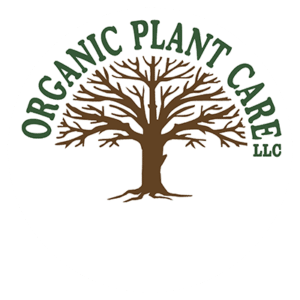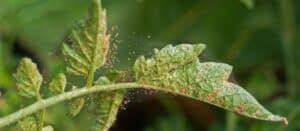Are you noticing more trees with dried or scorched-looking leaves? It could be caused by heat stress and water stress, both of which are common in many trees during our hot New Jersey summers. It could also be due to over-fertilizing trees and gardens (also very common). However, there’s another disease that shows very similar symptoms: Bacterial Leaf Scorch, or BLS.
Unlike heat and water stress – which are abiotic symptoms, meaning they are the result of physical conditions – BLS is biotic, meaning that a living organism is causing the disease. And while this difference may not sound serious, it is. New Jersey’s beloved state tree Quercus rubra, the Red Oak, is one of the main trees affected by BLS, and BLS has no cure.
What causes Bacterial Leaf Scorch?
Bacterial Leaf Scorch is caused by a destructive bacterium called Xylella fastidiosa. The name Xylella comes from the Greek word xylem, the name of the vital tissue inside trees that transfers water and water-soluble nutrients up from the tree’s roots to its branches and leaves.
How does BLS affect trees?
BLS affects a tree’s ability to provide sufficient water and nutrients to its leafy crown, resulting in brown, dead leaf tissue.
Trees that are water-stressed show similar symptoms but can be treated by increasing irrigation to a tree’s roots. A tree infected with Bacterial Leaf Scorch won’t respond to increased watering.
Even trees planted in a protected or favorable location won’t look healthy or respond to irrigation if they’re infected with BLS.
BLS was identified in the 1980’s, and it has been seriously affecting trees in our area since the 1990’s.
BLS in trees has no cure.
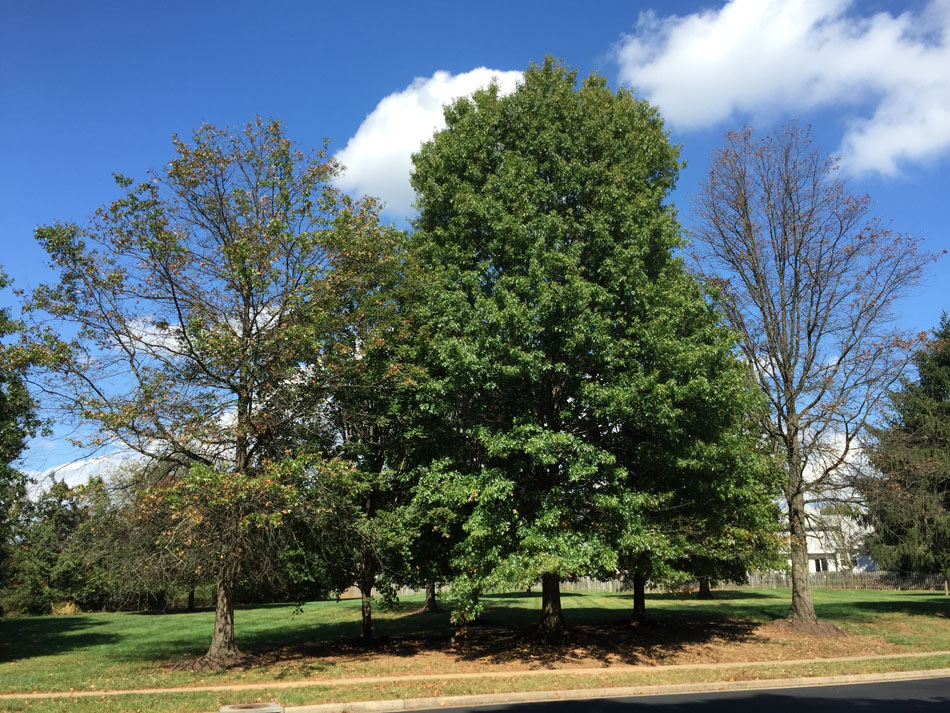
Two pin oaks suffering from bacterial leaf scorch surround a healthy pin oak tree.
By Famartin – Own work, CC BY-SA 4.0,
What does Bacterial Leaf Scorch look like?
Although it looks similar to leaf scorch caused by environmental factors, BLS on leaves displays a yellowed strip of leaf tissue between the healthy green portion of a leaf and its infected brown leaf tips or edges. Different tree species show differing patterns of the disease on their leaves, but the margin of yellow leaf tissue is common to all.
Since BLS damage shows up in late summer, when leaf scorch from drought stress is also present, it can be difficult to distinguish, so the yellow outline is a key identifier.
Another notable identifier is that leaf damage from BLS starts with older leaves and moves upwards to leaves at the tips of branches. In contrast, water stress typically affects new leaves first, as they are the most distant points a tree sends water to and require the most energy.
In order to accurately identify BLS, it must be analyzed in a lab. Rutgers University has a diagnostic plant laboratory, and you can search for BLS information on its website.
Bacterial leaf scorch will also stand out during summers that are not excessively hot and that receive enough rainfall to keep trees hydrated. Healthy, uninfected trees will have full, leafy crowns and show no signs of water stress. BLS infected trees will have scorched leaves despite the ideal growing conditions.
What happens when a tree is infected with BLS?
It can take several years after a tree is infected with BLS before the disease is identified, in part because the disease may first be limited to a few leaves or one branch. Successive years will bring more areas of damage until the entire crown displays scorched leaves.
Once leaf tissue is infected with BLS it can’t photosynthesize, which means it cannot make food energy from sunlight for the tree to store. This lack of energy production means a tree must use its existing stored energy reserves until they become depleted. When enough leaves on a tree are infected, the tree can’t support its crown and will begin to drop branches in an effort to reduce its mass and the amount of energy it requires.
As with most stressed trees, new growth may appear as suckers, or epicormic sprouts. These undersized stems appear when a tree’s crown declines and its leaves can’t generate sufficient food energy; the tree tries to compensate by making new leaves.
How does the disease spread?
The BLS bacterium is spread by insect vectors, or carriers. The insects identified as vectors include leafhoppers, sharpshooters, and spittlebugs; all are insects that bite into leaves and suck out sap. These insects are in the same family as cicadas but much smaller and more camouflaged, making them difficult to spot.
FUN FACT: Sharpshooter insects got their common name from scientists because the leaf surface damage they cause looks like tiny bullet holes, and because they “shoot” out precise streams of the excess water they extract from leaf sap.
These leafhopper insects move rapidly from tree to tree and can travel long distances, spreading BLS as they go.
If insects carry the bacterium, how does it get into my trees?
Female insects lay their eggs on leaves or in the crevices of tree bark. After overwintering, these eggs hatch in spring and the nymphs (immature insects) land on leaves and begin extracting sap.
BLS comes into the picture when insects feed on trees that have already become infected with the BLS bacterium. When a leafhopper insect pierces a leaf of an infected tree, it sucks in sap that contains the bacterium. The BLS bacterium then settles inside the insect’s mouthparts. When the insect moves on and bites into a healthy tree, the bacteria is transferred into the healthy tree.
Once the bacterium enters a tree, it rapidly finds its way into the tree’s water-transferring system, its xylem tissue. Once the bacterium multiplies and spreads up and down the tree’s xylem tubes, it will damage and clog the tubes and the tree will start to decline.
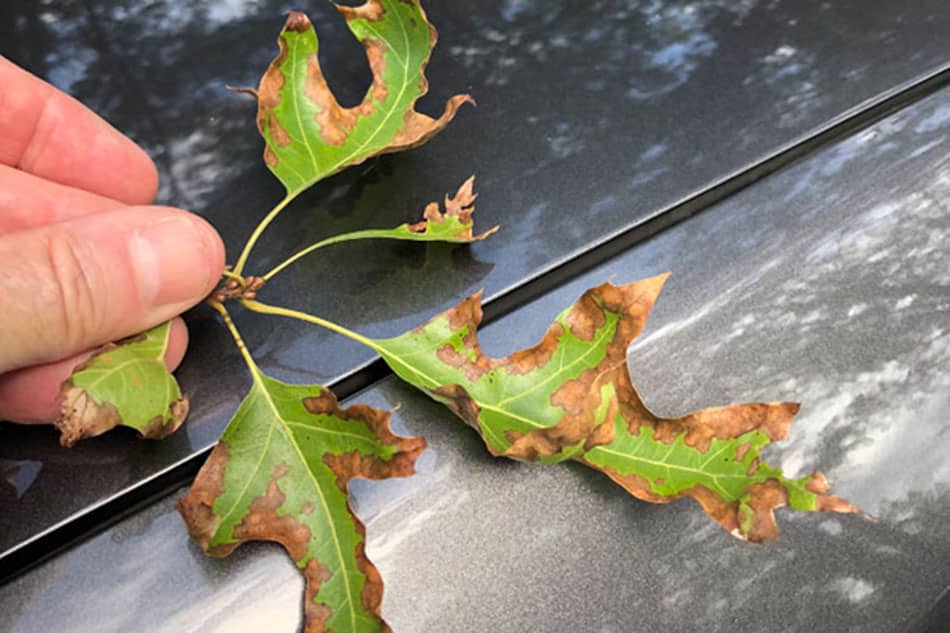
Close-up of bacterial leaf scorch affecting pin oak leaves.
Which trees are most often infected with Bacterial Leaf Scorch?
In New Jersey, it is primarily the Northern red oak (Quercus rubra) that becomes infected with BLS; both urban and forest red oaks have tested positive for BLS.
Other oak species within the red oak group, such as pin oak (Q. palustris) and scarlet oak (Q. coccinea), have also been infected, as well as oaks from the white oak group and other tree species.
A partial list of trees that are often infected by BLS includes:
Maples (Acer species)
- A. rubrum – Red maple
- A. negundo – Boxelder
- A. saccharum – Sugar maple
- Cornus florida – Flowering dogwood
- Celtis occidentalis – Hackberry
- Liquidambar stryraciflua – Sweet gum
- Morus alba – White mulberry
Sycamores (Platanus species)
- P. occidentalis – American sycamore
- P. x acerifolia – London plane
Oak (Quercus species)
- Q. velutina – Black oak
- Q. incana – Bluejack oak
- Q. macrocarpa – Bur oak
- Q. prinus – Chestnut oak
- Q. laurifolia – Laurel oak
- Q. virginiana – Live oak
- Q. stellata – Post oak
- Q. imbricaria – Shingle oak
- Q. shumardii – Shumard oak
- Q. falcata – Southern red oak
- Q. bicolor – Swamp white oak
- Q. nigra – Water oak
- Q. alba – White oak
- Q. phellos – Willow oak
American elm (Ulmus americana)
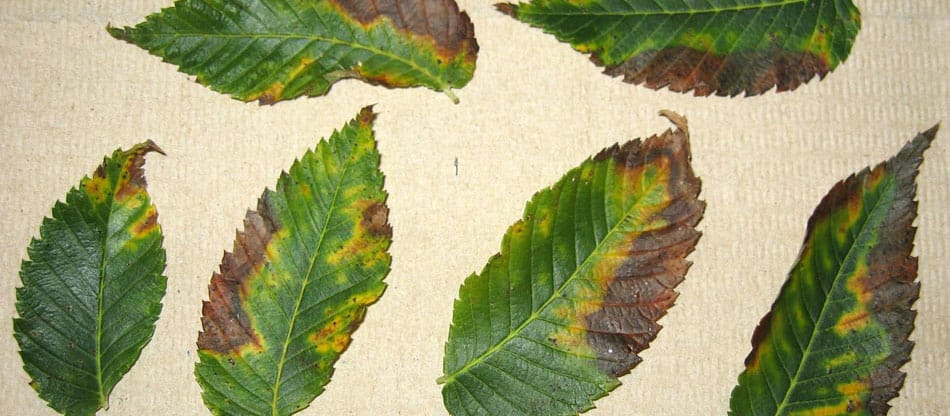
Bacterial leaf scorch symptoms on elm leaves. Photo by Sandra Jensen, Cornell University, Bugwood.org.
Why do stressed trees get BLS more often?
Environmental stresses, such as heat and drought, don’t cause the BLS bacterium to infect trees. However, trees that are already stressed by these conditions can be targeted by the insects that spread the disease.
Insects have a superior ability to identify and attack stressed trees, whose resistance to pests and diseases is lower than that of healthy trees. And trees infected with BLS are then, in turn, more susceptible to other pests and diseases.
How can I prevent BLS?
It’s hard to control the spread of BLS because the insects that transmit it are hard to control, and because they feed on so many host plants. In addition to trees, shrubs and smaller plants have been identified as BLS hosts, increasing the opportunities for sap-sucking insects to take in the bacterium.
There are several things you can do to limit or prevent BLS:
- Choose BLS-resistant tree species
- Remove infected and declining host trees
- Keep your trees and your garden healthy
Which trees are resistant to Bacterial Leaf Scorch?
Some white oak group species are less susceptible to BLS than red oak species, and other tree genera have also shown some resistance. Resistant trees include:
- Nyssa sylvatica – Black tupelo or black gum
- Fagus sylvatica – Beech
- Aesculus species – Buckeye
- Tilia americana – American linden
- Zelkova serrata – Japanese zelkova
NOTE: Before choosing a tree species based on its resistance to BLS, be sure to check its resistance to other pests and diseases that damage New Jersey trees.
In addition to choosing resistant species, another sound practice has always been to mix species of trees instead of planting a single species, or monoculture. Having a mix of trees always reduces the spread of disease as mixed crop planting reduces insect infestations.
If you plan to swap out BLS affected trees for more resistant species, plant your resistant species first. This allows them to settle in and grow larger before you remove the more mature, affected species. Trees growing together help each other and share resources, grow faster, and are generally healthier than lone specimens.
What can I do to keep my trees healthy?
Keeping your trees and your entire garden healthy can also reduce the incidence of Bacterial Leaf Scorch. Trees that receive enough water and nutrients are naturally more resistant to pests and diseases, so be sure to:
- Check your irrigation system to make sure it’s working as scheduled and adjust it as needed
- Maintain mulch around the dripline of your trees
- Enrich your soil with compost or compost soil conditioner for improved soil texture and water-holding capacity
- Protect your trees from damage by mowers, string trimmers, and other equipment.
And although we say this all the time, it bears repeating again here:
A healthy garden should always have a mix of plants (including native plants) that attract wildlife, beneficial insects, pollinators, and beneficial predators. This is especially important for BLS because the leafhopper insects that transmit Bacterial Leaf Scorch can be eaten, killed, or parasitized by beneficial predators! These predators include tiny parasitic wasps, praying mantises, dragonflies, spiders, and songbirds.
Are there any treatments for Bacterial Leaf Scorch?
There’s no known cure but a 2-pronged treatment approach consisting of an antibiotic and a substance that thickens the leaf surface so it’s less vulnerable to leafhoppers can be effective in keeping trees healthier and looking better for longer.
The regimen of antibiotics is injected into the trunk of infected trees to manage the symptoms of BLS. These injections need to be done by professionally-trained applicators (such as a Certified Arborist) and can control the symptoms of the disease.
You can also prune off the affected branches of BLS-infected trees to improve their appearance although, once again, it will not stop the disease. If you do prune infected trees, disinfect your pruning tools between each cut with a bleach solution to prevent spreading the bacterium further in infected trees or passing it to uninfected trees.
A FINAL WORD ABOUT BACTERIAL LEAF SCORCH
If BLS sounds like bad news all around, it is. Along with other pests and diseases that have no remedies, Bacterial Leaf Scorch threatens our familiar shade trees and we can’t yet cure it.
We’re here to give you the best information to keep your trees and your garden healthy, as well as provide realistic options for treating pests and diseases.
If you have trees you think might be infected or at risk of developing BLS, contact us for an assessment. We can diagnose the issue and see whether treatment will be helpful.
GET THE LATEST NEWS
Subscribe to the Organic Plant Care Newsletter and get timely and helpful tips and updates monthly.
There's no spam - we promise!
